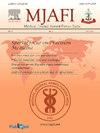Specialty preferences of undergraduate medical students: What do they choose and why?
Q2 Medicine
引用次数: 0
Abstract
Background
The choice of choosing a specialty after completing MBBS is influenced by multiple factors. Personality traits like extraversion, agreeableness, conscientiousness, neuroticism, and open-mindedness form the intrinsic factors. Factors like early financial stability and cost of education form the external factors. This study evaluates the association between these factors and the specialty choice.
Methods
This was a cross-sectional study including students from first year to intern doctors in India. An online questionnaire was used for data collection which included questions about demographics, choice of specialty, personality traits, and external factors affecting their choice. The Big Five Inventory-2-S 30-item Scale (BFI-2-S) was used to assess the personality traits.
Results
One thousand nine hundred and twenty-one students participated in this study (57.6% females). Most participants, 1761 (91.7%) opted for clinical branches. Only 13 (0.7%) students wanted to pursue a non-clinical branch. Only 20 (1.0%) participants wanted to pursue a pre-clinical branch. Participants who opted for clinical branches were more extraverted, and more open-minded than those who chose non-clinical branches. Participants who opted for surgical branches were more extraverted, more conscientious, and had fewer negative emotions than their peers who chose medicine-related branches. High income generated per annum (65%), early financial stability (within 2–5 years) (60.7%), cost of postgraduate education (46%), and gender predominance (35.3%) were the most influential external factors.
Conclusion
These findings show that there are distinct personality traits and external factors associated with specialty choices. This will aid counselors to guide undergraduate medical students to choose a specialty for post-graduation.
求助全文
约1分钟内获得全文
求助全文
来源期刊

Medical Journal Armed Forces India
Medicine-Medicine (all)
CiteScore
3.40
自引率
0.00%
发文量
206
期刊介绍:
This journal was conceived in 1945 as the Journal of Indian Army Medical Corps. Col DR Thapar was the first Editor who published it on behalf of Lt. Gen Gordon Wilson, the then Director of Medical Services in India. Over the years the journal has achieved various milestones. Presently it is published in Vancouver style, printed on offset, and has a distribution exceeding 5000 per issue. It is published in January, April, July and October each year.
 求助内容:
求助内容: 应助结果提醒方式:
应助结果提醒方式:


